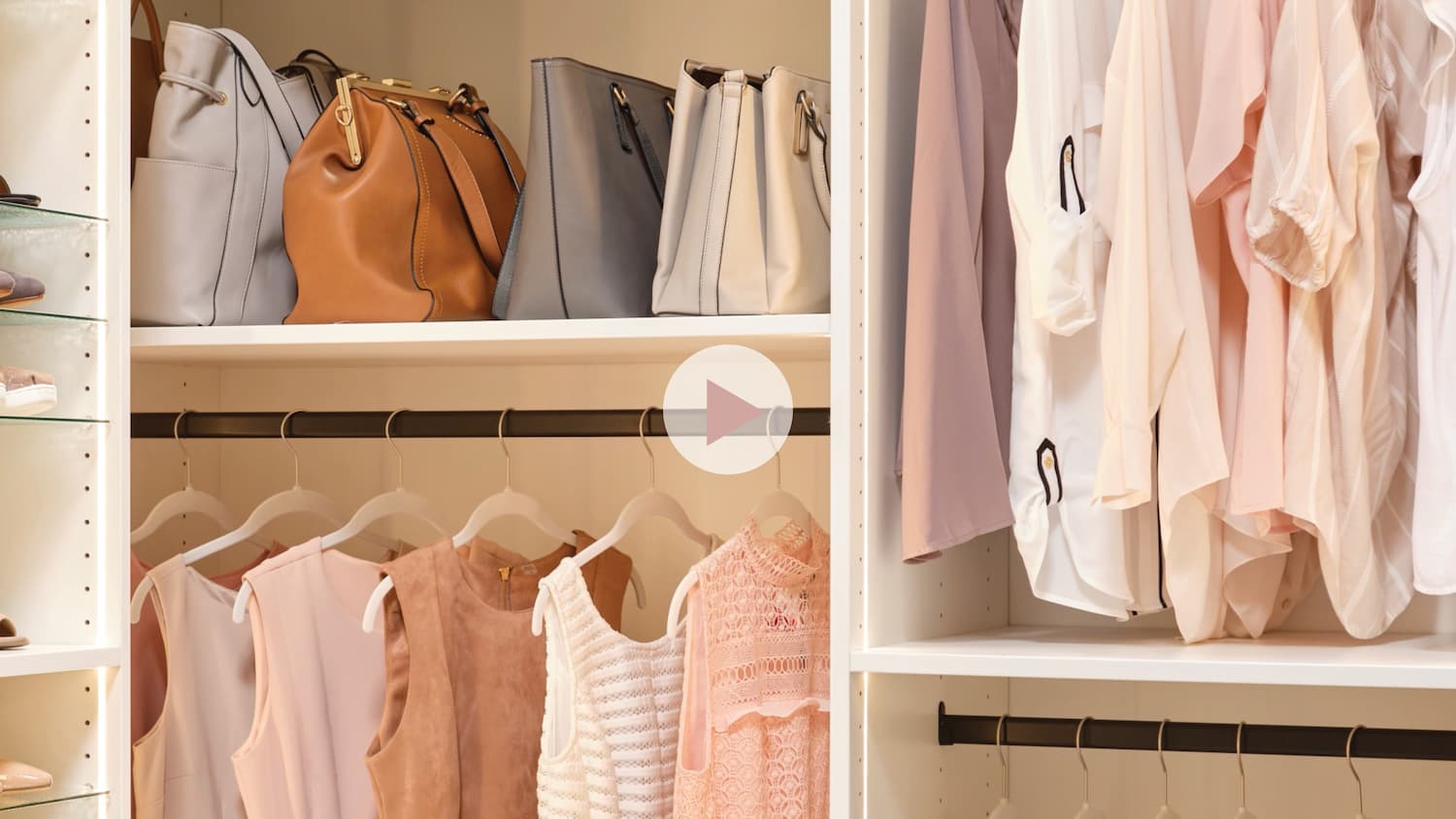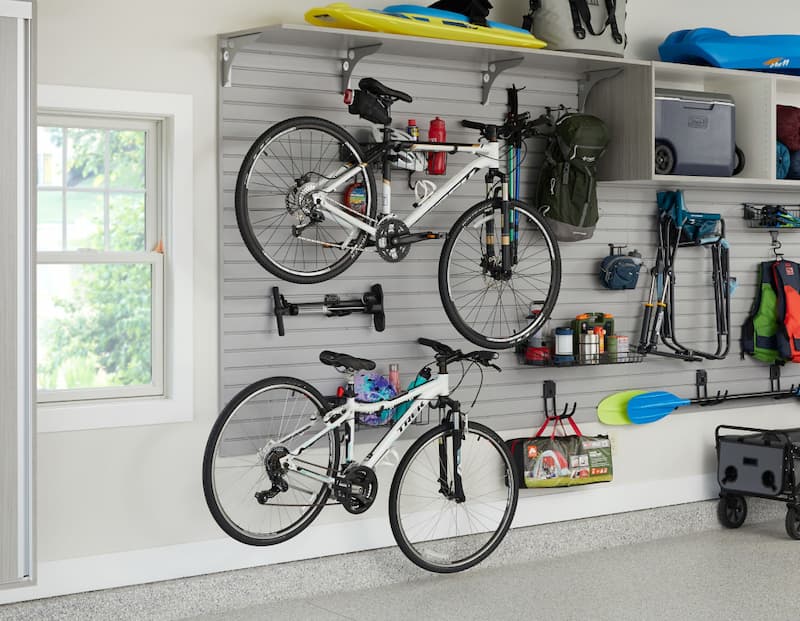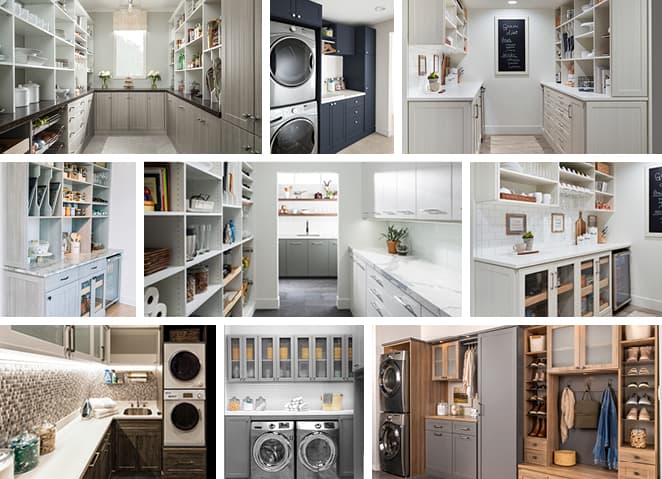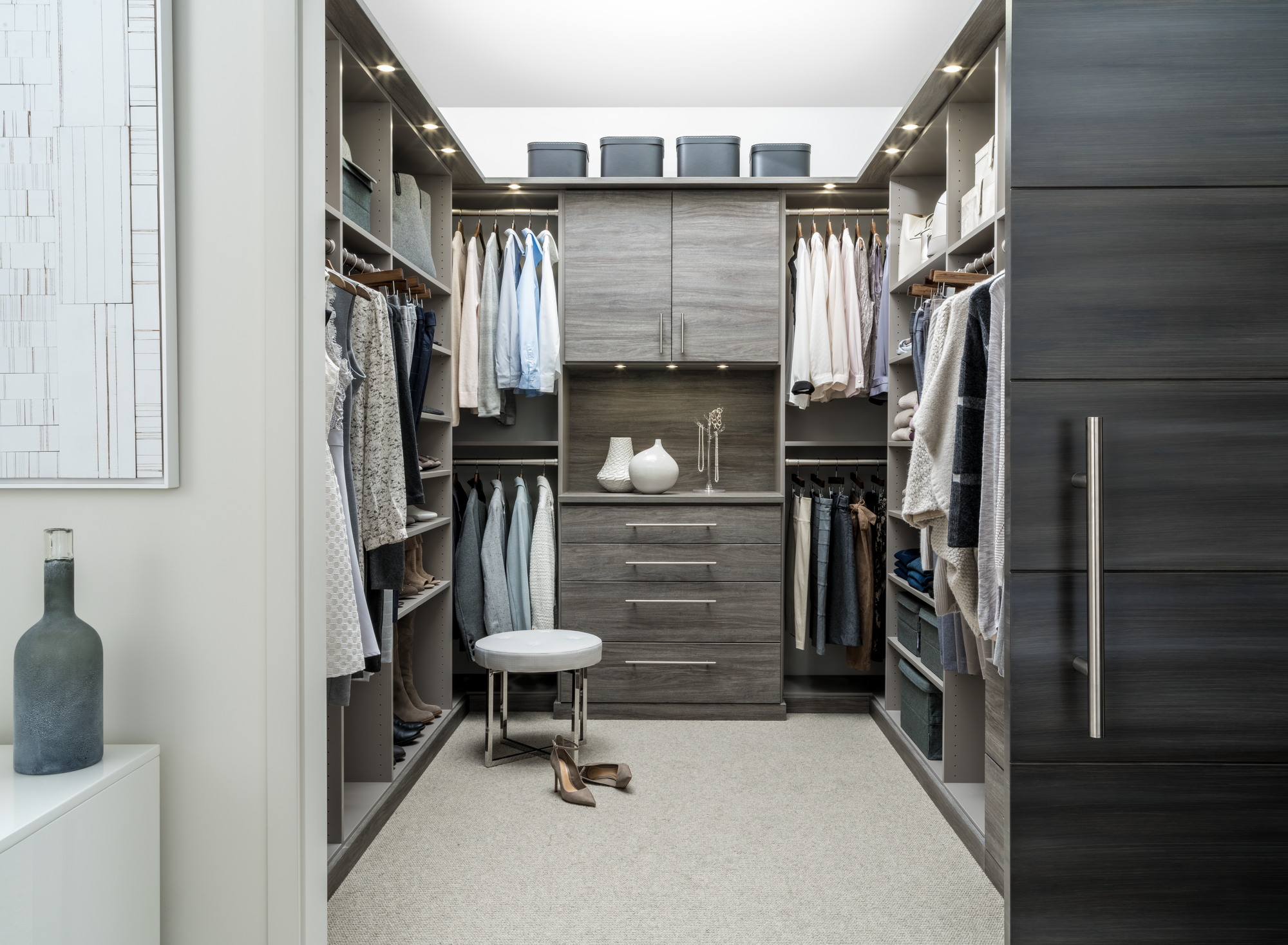
How To Organize Purses
in Your Closet
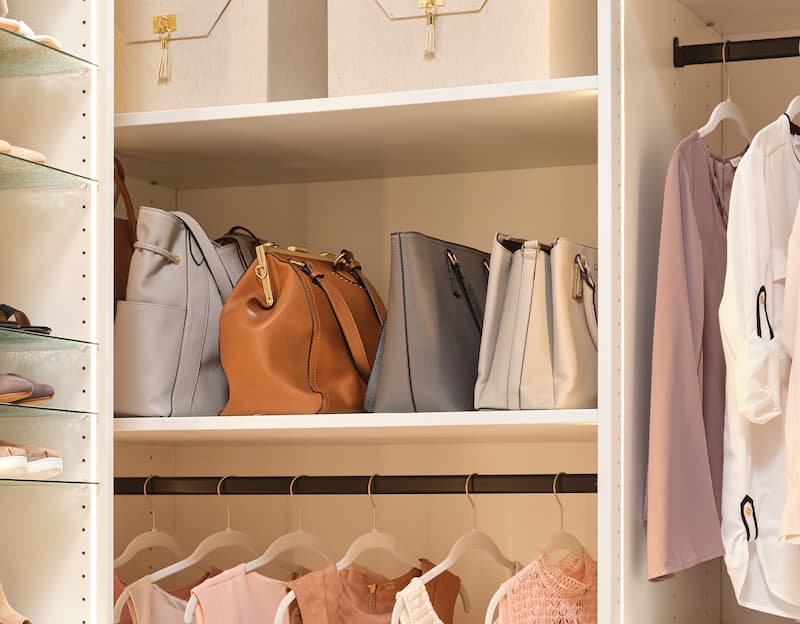
They say purses are like friends… you can never have too many. From clutches and crossbodies to backpacks, bucket bags, and totes, nothing haunts us more than the purse we didn’t get, except maybe how to organize purses in our closet and the mess of purses crammed onto the shelf in our closet. While purses top the list of most useful accessories, purse storage and understanding how to organize purses in a closet seems to elude us. But like a tried-and-true best friend, our purse is there when we need it–that is, when we can find it. If organizing handbags in a closet has you frustrated, we can help.
Speaking of lost and found and lost again, if you’re like us, your purse is sitting somewhere along the path from the car to the closet and never in the same place twice. Most often found sitting on the kitchen counter, kitchen island, hanging from a chair, or sitting in the corner of a nearby couch, suddenly the purse you need and love becomes the frustration you don’t. With so much on your mind, your purse, like other accessories (ahem… keys, sunglasses), is easily set down in various spots and often found in different locations throughout the house. Without a dedicated spot, your purse storage becomes a point of frustration and always at the most inopportune time.
If you’re longing for a better way to organize handbags in your closet, it might be time to take the next step in your handbag organization game. Below are our tips for better handbag storage that will simplify your life.
First, find a home for your everyday purse
To keep track of your go-to, everyday purse, create a dedicated space in your home that’s easy to remember and easy to access. Here are some places to consider:
Home Office
Whether you have a dedicated home office or a desk that’s part of another room, your home office is a great, out-of-the-way place for purse storage, especially if your computer bag doubles as your everyday purse. Tucking it under your desk or hanging it from a nearby hook is a great way to stay organized.
Coat Closet
Coat closets aren’t just for coats: they’re a great option for closet handbag storage. A common feature in most homes, a coat closet is a convenient, easily accessible place to hang purses and store handbags

Family-ready Room
Found in many new homes, the family-ready room is, well, quite genius. Located between the garage and kitchen, these hard-working rooms often bring together the laundry room, entryway lockers, a second refrigerator, a pet washing station, and additional cabinets and countertop space for the items you need to set down on your way in, which includes your purse.
Pro Tip
Avoid hanging your purse on the backs of chairs or setting it on the kitchen counter or dining room table. While it can be easy to do after a long day, it adds clutter and chaos to your space.
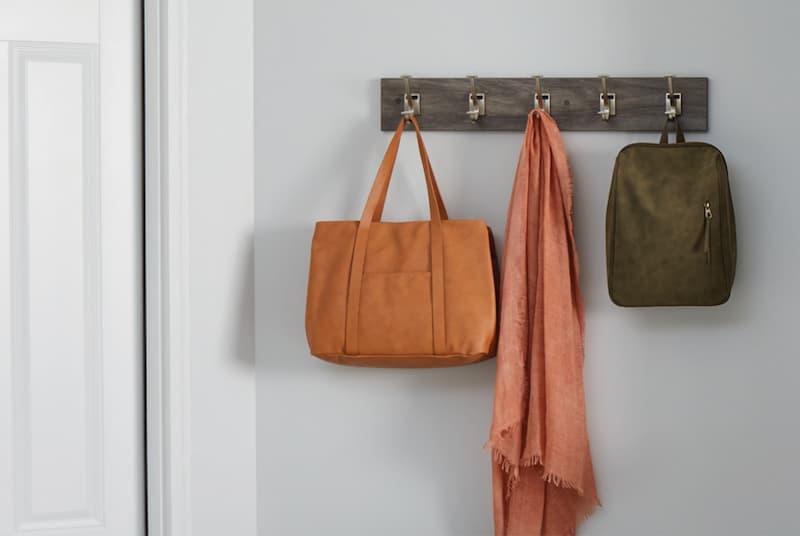
Entryway/Drop Zone
Keep it simple by storing your purse in your entryway. Hang your purse from already established coat hooks or create a dedicated nook for purse storage within a cabinet for quick and easy access.
Pro Tip
If you change purses regularly, perhaps daily, create a dedicated space for unpacking and repacking. For easy access, we recommend switching purses near where you keep your unused purses.
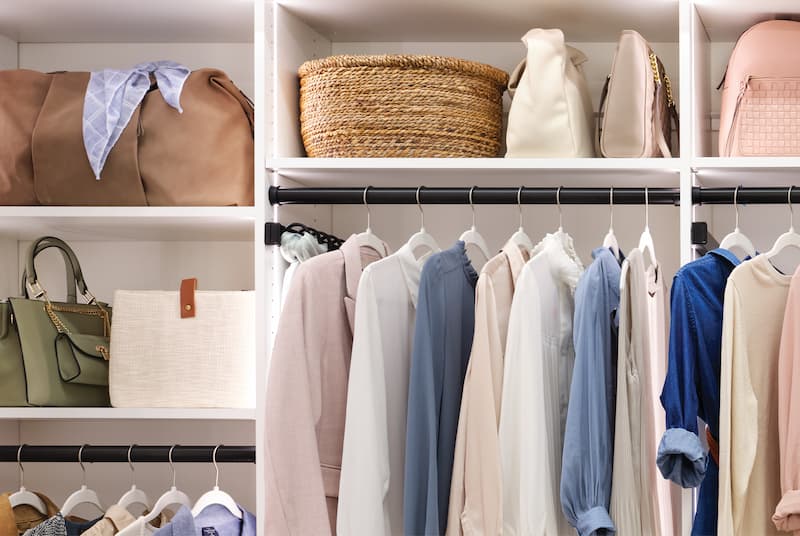
Bedroom Closet
One of the most convenient places to store handbags is in your bedroom closet – especially if your bedroom is on the main floor. By storing your handbag here, your bedroom closet can become a one-stop shop to get dressed and fully ready for the day.
Pro Tip
Creating a dedicated purse storage space is the first step, but consistency is how you achieve your long-term purse organization goals. No matter where you choose to store your purses and handbags at home, do your best to continue placing them there day after day and soon it will be part of your everyday routine.
Second, find the closet accessory organization method that’s right for you
Organization is very personal. What works for one may not work for another and organizing handbags in a closet is no different. Regardless of the number of purses and handbags you own, finding a purse storage method that works best for you is the key to consistency and it starts by thinking about how you think.
By Type
The type of purses you own likely range from small, sophisticated clutches to big, all-purpose tote bags. If you often find yourself searching for “that one crossbody” or “that favorite saddle bag”, you’re likely someone who thinks about the type of purse you need first, which means organizing by type could be your best purse organization method.
By Color
Purse organization by color is another popular method. If color coordinating your purse with your outfit is important to you and color is what you think of first when choosing a purse from your closet, consider organizing your handbags in this way.
By Activity
If you tend to think about where you’re going and what you might need in that environment, then organizing your purses by activity or event will work best. Some of the more common activities are:
By Style
If things like shape and stitching or strap detail matter most to you when choosing which purse to use, then consider organizing purses in your closet by style. For example, keep all your crescent shaped purses together and all your purses with quilted styling or chain straps together.
By Size
If you think about size first, then purse organization from largest to smallest makes it easy to find the size that fits the need.
By Season
Changing purses seasonally is quite common especially when transitioning from spring/summer to fall/winter. This is especially true for everyday purses or the ones you use most. To make it easy, organize by season. Bonus: doing so may keep you from buying a purse you may not need.
Third, take a multipronged approach to organizing purses in a closet
If you have the space to create a purse storage area in your closet, we recommend a multipronged approach that accommodates the range of purses and handbags you own from the everyday purse to the designer handbag.

Hanging from a Purse Hook
Ideal for the purse your currently using, we recommend hanging purses on purse hooks located close to the closet door for ease and convenience when storing your handbags in a closet.
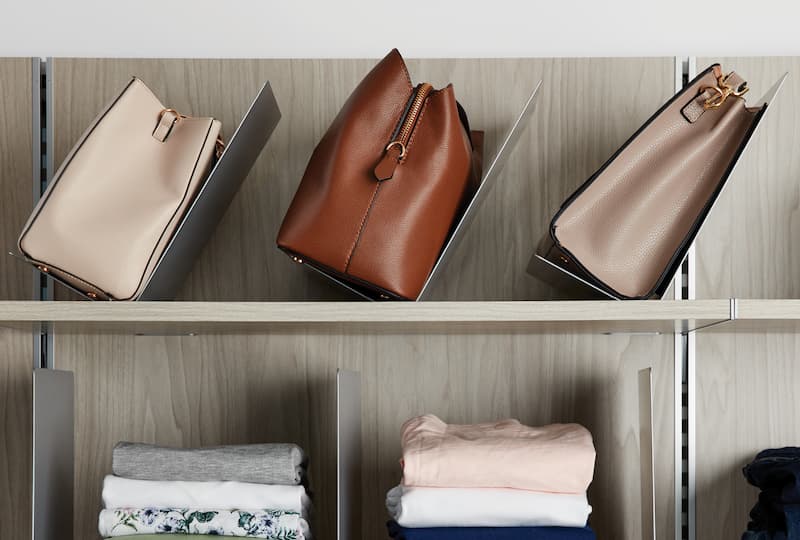
Sitting on a Purse Perch
Ideal for keeping a smaller number of purses organized, upright, and separated from each other.
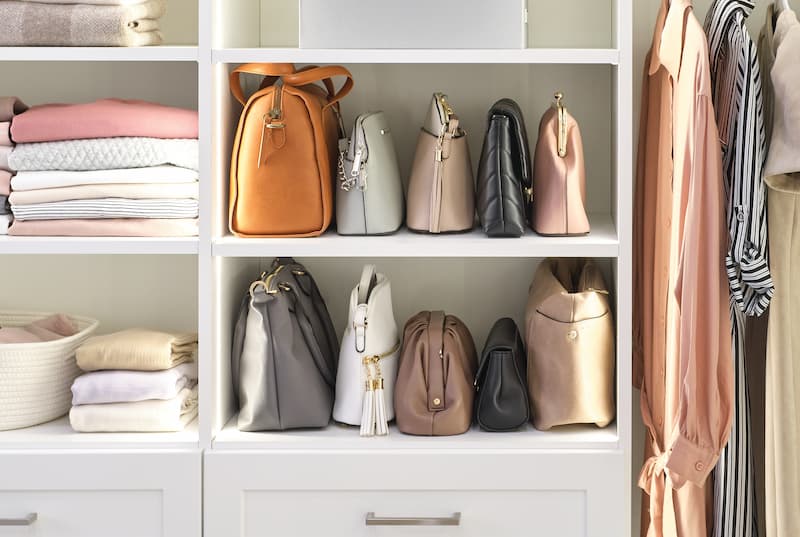
Lined on an Adjustable Shelves
Having multiple shelves is ideal for organizing a larger number of purses and creates an intentional destination within your closet making it less likely that you’ll set your purses in different spots around the house.
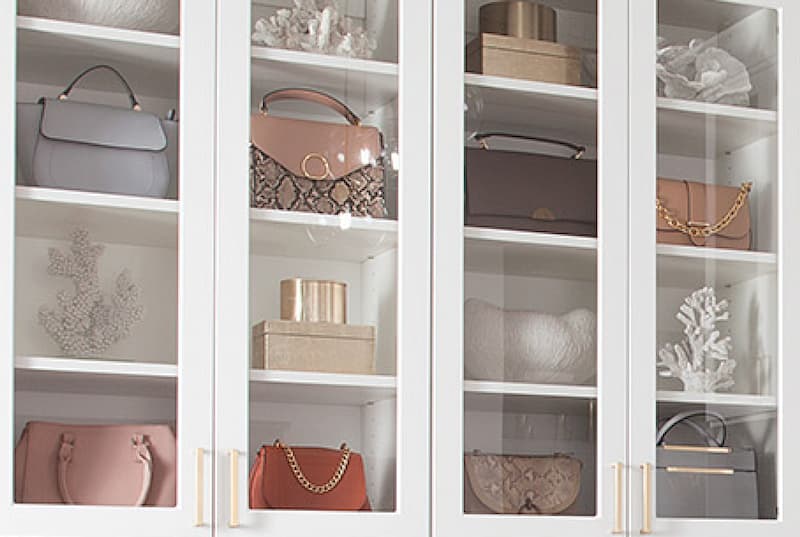
In Glass-front Cabinets
Glass-front cabinets are an ideal way to store designer purses or heirloom purses you want to protect from everyday wear and tear creating both a beautiful display and helpful purse organization.
Helpful Handbag Storage Tips
Now that you’ve found your perfect handbag organization area and method, keep these helpful storage tips in mind to maintain cleanliness and keep your handbags in pristine condition:
Avoid
Stay away from large bins, totes or baskets to store your purses. By tossing your bags into one tote, you’re not only creating unnecessary organizational chaos, but potentially damaging the fabric and material of your purses and handbags.
Clean
Always wipe down the outside and inside of your bag before storage. Be sure to research the manufacturer’s care instructions before you clean your handbag to ensure you won’t damage the material.
Stuff
To help maintain your handbag’s natural shape, use soft cloths, old scarves or even clean paper towels to stuff your bag. However, be careful to not overstuff the bag to not add stress on the bag’s stitching and materials.
Tuck
Tuck in any heavy accessories, chains or straps into the bag to ensure they don’t leave marks on your handbag while in storage.
Cover
If you have it, be sure to store your bag in its dust bag to protect it from discoloration and debris. For your most sensitive, precious purses, store them in a box to protect them further.
Cool
Heat and humidity can warp and deteriorate the materials in your handbag. Be sure to store purses in a cool, dry, dark area like a closet to help retain your bag’s natural look and shape.
Now you know how to organize your purses
Purse organization can be challenging, but with the help of the experts at Inspired Closets, it doesn’t have to be. Backed by years of experience, we can help you create the right purse organization solution for the space you have and the handbags you own. Give us a call or complete this form to get started.
Recommended for You

Love What You See?
Our designers are great listeners, and fabulous at what they do, too, so let’s talk. Oh, the best part? Our in-home design consultations are free. Yep. FREE! Let’s get started.
"*" indicates required fields


